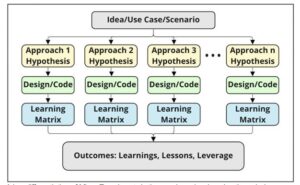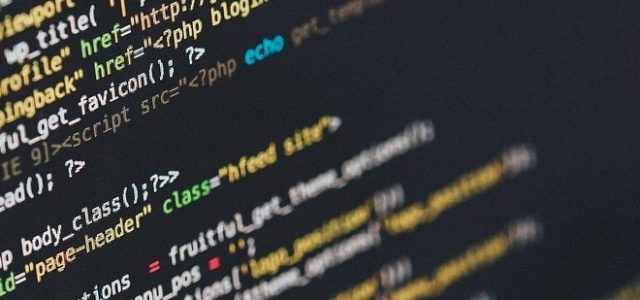Involving engineering teams across the value stream in the discovery and adoption of new technologies promotes advancement of new ways of working and accelerates innovation by leveraging discoveries.
What is a Micro-Experiment?
- “Experiment-Driven Development (EDD) is a scientific, fact-based approach to software development using agile principles.” – Understanding ExperimentDriven Development
- “Hypothesis-driven development is based on a series of experiments to validate or disprove a hypothesis in a complex problem domain where we have unknown-unknowns. We want to find viable ideas or fail fast.” – Why hypothesis–driven development is key to DevOps
- “Experiment-driven product development (XDPD) is a way of approaching the product design and development process so that research, discovery, and learning—asking questions and getting useful, reliable answers—are prioritized over designing, and then validating, solutions.” – Experiment–Driven Product
Development: How to Use a Data–Informed Approach to Learn, Iterate, and Succeed Faster November 21, 2019, Paul Rissen, Apress
What a Micro-Experiment is not:
- A Proof of Concept (PoC) is generally one approach that demonstrates feasibility, however, it lacks the rigour and confidence provided by the many approaches examined in a micro-experiment.
- A Minimal Viable Product (MVP) provides enough features to attract early-adopter customers and validate a product idea while a micro-experiment’s scope is limited to a single hypothesis/concept under intense evaluation.
Why Micro-Experiment?
- Micro-Experiments allow teams to ask and answer questions in a structured, measurable process. Since ideas are validated by hypotheses, teams avoid the testing of ideas simply to validate individual egos or hunches.
- While agile methodologies dictate that value to the end-user is the primary goal, the hypothesis-driven approach of Micro-Experiments forces teams to define value objectivity through validated learning and not assumption alone.
- Efficiency is increased by building an intentional/purposeful Micro-Experiment instead of focusing on cool/superfluous features that provide little benefit to the end-user.
- Teams leading with Micro-Experiments accelerate time to value (by up to 50%) with increased confidence. This is because good micro-experiments thoroughly vet failure paths (fail-fast) that ensure chosen paths can execute with greater confidence.
How to Micro-Experiment:

A key differentiation of Micro-Experiments is they are based on learning through rigorous examination using many approaches. This results in zero to many viable solutions that can be selected by their appropriateness to specific criteria.
The first rule of Micro-Experiments is the code lives and dies in the sandbox. The second rule of Micro-Experiments is THE CODE LIVES AND DIES IN THE SANDBOX. Period.
The Idea
- Identify the underlying purpose and goals of the Micro-Experiment.
- Clarify what is in and what is out of scope.
- Keep it crisp & concise.
Example: Evaluate the performance, cost and scaling factors of cloud compute options for web apps. • In Scope: AWS, Azure, GCP
- Out of Scope: On-premises Kubernetes
The Approaches
- One approach is a Proof of Concept that can easily fall into scope-creep. Avoid this. Instead, consider multiple viable and nonviable approaches to deepen learning takeaways.
- For each approach, formulate a hypothesis that defines the smallest intentional/purposeful outcome that will prove or disprove it. Connect the hypothesis to customers, problems, solutions, value, or growth where possible.
- A hypothesis should be simple & direct, “By doing this, we expect that to happen which benefits by why…“
Example: By using Azure App Services (code deployment), we expect the developer to require little-to-no knowledge around app hosting& operations which will allow them to focus on exceeding customer expectations.
The Design & Code
- Decide how you should implement each approach: same team for all approaches vs. different team per approach. Weigh the pros & cons against team capability & maturity.
- Leverage patterns & best practices. Platform/product vendors generally have an abundance available to choose from.
- Keep the design & code concise & simple focused solely on the outcome to be measured.
- A Micro-Experiment need not adhere to the code disciplines and rigor that production code requires (e.g., no 12-Factor App here).
- A half day to a day is a common goal for implementing an approach.
- Design & code each approach and then measure progress based on selected criteria and validated learning (matrix below).
- A Build/Measure/Learn loop is recommended.
The Learning Matrix
Capture all the significant and insignificant details of each approach in a matrix. The Learning Matrix is for collecting raw data, not judging (that comes later in Outcomes). Failures are equally if not more important than successes.

The attributes of the Learning Matrix can shift over time, however, the following represent the core:
- Hypothesis – capture the hypothesis for the approach.
- Architecture-Design — capture any patterns & artifacts relevant to the approach.
- Spin-up to Dev Time/Difficulty – capture the effort and time to become productive using this approach.
- Pipeline & Time to Deploy – capture/summarize the steps, effort and time to deploy the approach into an active test state.
- Security Coverage & Complexity – when applicable (almost always), capture this approach’s impact to effective security practices and the complexity involved to do so.
- Cost – capture cost of the approach – actual measured costs are best – use “calculators” when actual costs cannot be measured directly. Extrapolate data to estimate costs at production scale.
- Performance – leverage built-in platform monitoring and test tools to capture approach performance and duration metrics: avg, min, med, max, percentiles p90 & p95.
- Scale – utilize the “Boeing wing stress test” method (stress it until it breaks) to determine the upper limits of scale-out and scale-up for each approach. Never test to a target goal.
- Resiliency & Availability – capture the approach’s robustness by calculating the elemental metrics that determine what SLA can be achieved.
- Pain Points – capture any process, tool, dependency, limiting, and anecdotal hurdles and roadblocks encountered implementing each approach.
- When to Use & Avoid – clearly & concisely capture and articulate when each approach should be used and when they should be avoided. Start each statement with, “Use when…” or “Avoid when…”
The Outcomes
Overall, Micro-Experiments should effectively Analyze, Learn, & Leverage. What were the observations? How might the validated learnings be leveraged?
Consider the following when compiling Micro-Experiment Outcomes:
- Prove a Hypothesis and Win!
- Disprove a Hypothesis and Win! Knowing what fails is often the greatest lesson(s) learned.
- By learning what fails, teams can proceed with high confidence when selecting approaches to pursue further.
- Leveraging “When to Use/Avoid” allows there to be multiple “winners” providing Dev multiple choices to utilize as surrounding criteria changes and requirements evolve.
What is the Time Commitment/Value Return?
Teams that leverage Micro-Experiments & EDD typically will dedicate 1-2 weeks to execute their approaches and analyze their outcomes. The following represents the results experienced:
- Teams leveraging learnings when applying this concept see a reduced time-to-production by up to 50%. It takes simply takes far fewer sprints.
- Teams realize fewer “gotchas” as this immersive and exhaustive learning includes becoming an expert in failure paths as well as successful paths.
- Teams move forward with confidence as they’ve learned what breaks, when it breaks, how it breaks, and why it breaks.
- Teams can quickly pivot to different approaches as real-world factors change over time.
- Hands-on Micro-Experiments land learnings much deeper and teach teams to rely on empirical data & experience from the scientific method.
Header Image by John Adams on Unsplash
Article by channel:
Everything you need to know about Digital Transformation
The best articles, news and events direct to your inbox
Read more articles tagged:






